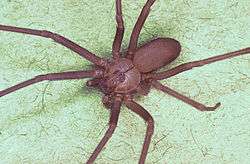Sicariidae
| Recluse spiders | |
|---|---|
 | |
| Brown recluse spider | |
| Scientific classification | |
| Kingdom: | Animalia |
| Phylum: | Arthropoda |
| Class: | Arachnida |
| Order: | Araneae |
| Suborder: | Araneomorphae |
| Superfamily: | Scytodoidea |
| Family: | Sicariidae Keyserling, 1880[1] |
| Genera | |
| Diversity | |
| 2 genera, 122 species | |
 | |
| Synonyms | |
|
Loxoscelidae[2] | |
Sicariidae is a family of six-eyed venomous spiders known for their necrotic bites. The members of this family are haplogyne, possessing unsclerotised genitals in females. The family consists of two genera, Loxosceles and Sicarius, and contains about 132 species.[3] Well known spiders in this family include the brown recluse spider and the assassin spider.
Description
The genus Loxosceles, commonly known as recluse spiders or violin spiders, is distributed nearly worldwide in warmer areas. The genus Sicarius, or assassin spiders, are desert spiders that live in the Southern Hemisphere, in (South America and Africa), known primarily for their self-burying behavior. All have six eyes arranged in three groups of two (dyads) and the violin spiders are usually brownish with a darker brown characteristic violin marking on the cephalothorax. Sicarius resembles the crab spiders of the family Thomisidae and lacks this marking. Individual Sicarius can live for as much as 15 years, which makes these among the longest-lived araneomorphae spiders (some tarantulas can live well over 20–30 years.) Most Loxosceles can live for one and a half to two years. Members of both genera can live for very long times without food or water.
Medical significance
Both genera have potent tissue-destroying venoms containing the dermonecrotic agent, sphingomyelinase D, which is otherwise found only in a few pathogenic bacteria. Thus, the venom of Sicariidae is highly necrotic in effect, capable of causing lesions (open sores) as large as a US quarter (about one inch or 25mm in diameter). The wounds take a long time to heal and they may require skin grafts. If these open wounds get infected there can be serious consequences. Rarely, the venom is carried by the blood stream into internal organs causing systemic effects. The Chilean recluse (Loxosceles laeta), along with the African species of Sicarius, reportedly have a more potent venom, which results in systemic involvement more often.[4]
Genera
- Loxosceles Heineken & Lowe, 1832[1] (worldwide)
- Sicarius Walckenaer, 1847[1] (South America, Africa, Galapagos)
See also
References
- 1 2 3 Platnick, Norman I. "FAM. SICARIIDAE Keyserling, 1880: 267". World Spider Catalog, Version 14.5. Retrieved 2014-05-02.
- ↑ Gertsch, Willis John; Ennik, Franklin. "The spider genus Loxosceles in North America, Central America, and the West Indies (Araneae, Loxoscelidae).". Bulletin of the AMNH. 175. Article 3. Retrieved 2016-09-11.
- ↑ Platnick, Norman I. "Counts". World Spider Catalog, Version 14.5. Retrieved 2014-05-02.
- ↑ Binford, Greta J.; Wells, Michael A. (2003). "The phylogenetic distribution of sphingomyelinase D activity in venoms of Haplogyne spiders" (PDF). Comparative Biochemistry and Physiology B. 135: 25–33.
External links
| Wikispecies has information related to: Sicariidae |
| Wikimedia Commons has media related to Sicariidae. |
- "Loxosceles: Recluse spiders". Arachnology Home Pages.
- "Family Sicariidae". Biodiversity Explorer. Archived from the original on 2005-12-07.
- Vetter, R. (2003). "Causes of Necrotic Wounds other than Brown Recluse Spider Bites". University of California, Riverside.
- Vetter, R. (2003). "Myth of the Brown Recluse Fact, Fear, and Loathing". University of California, Riverside.
- "Pictures of the Brown Recluse Spider".